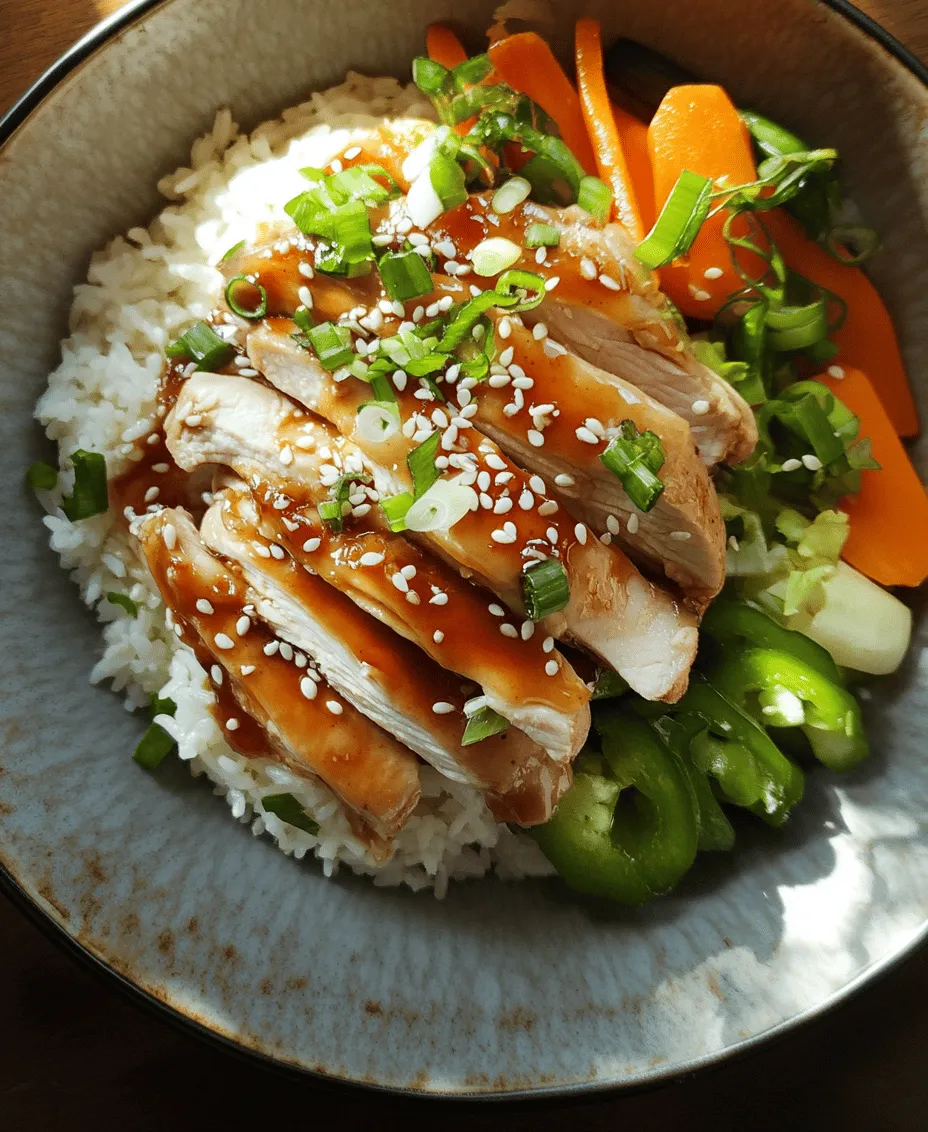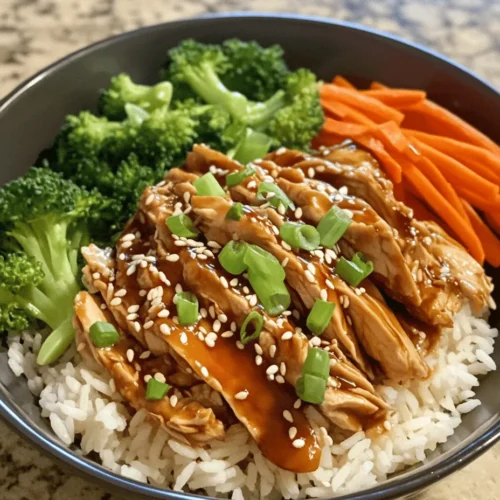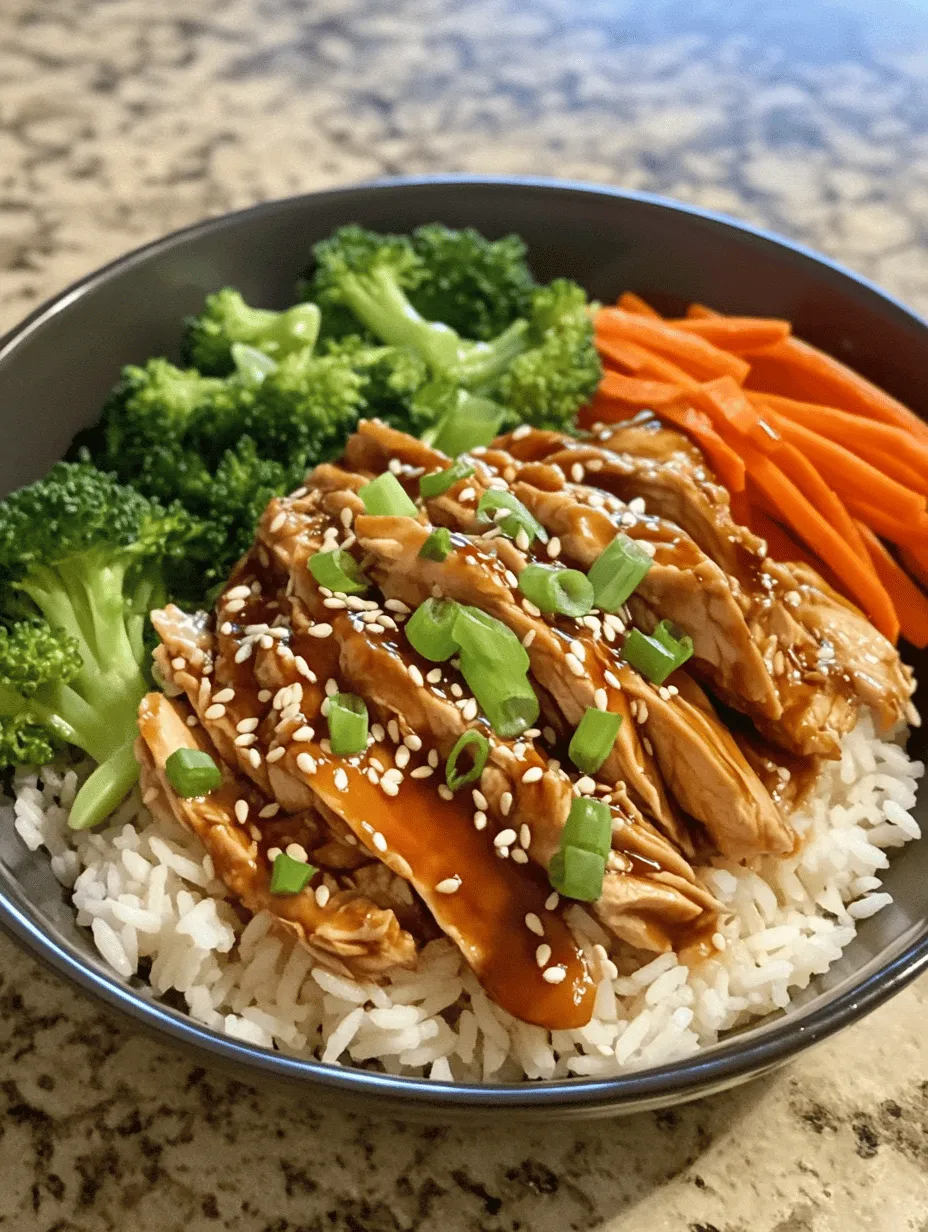Introduction
The Teriyaki Chicken Rice Bowl is not just a meal; it’s a beloved dish that encapsulates the essence of Japanese culinary tradition. This hearty bowl of tender chicken glazed in a rich, savory-sweet teriyaki sauce, served over a bed of fluffy rice, has become a favorite among food enthusiasts worldwide. Whether you’re enjoying a casual dinner at a Japanese restaurant or cooking at home, this dish delivers comfort and satisfaction in every bite.
In an age where fast food often reigns supreme, preparing homemade meals allows us to reconnect with the joy of cooking. Crafting a Teriyaki Chicken Rice Bowl from scratch not only fills your stomach but also nourishes your soul. The vibrant flavors and aromas that fill your kitchen will undoubtedly create a memorable experience, making it worth the effort.
This article will take you through the essential ingredients, the cooking process, and the joy of enjoying a wholesome meal that you’ve prepared with your own hands. Whether you’re a seasoned cook or a beginner, this guide will help you master this delightful dish in no time.
Understanding Teriyaki: The Essence of Flavor
What is Teriyaki?
Teriyaki, which translates to “glazed grill” in Japanese, is a cooking technique that involves grilling or broiling food, usually marinated in a mixture of soy sauce, sake, and mirin. The method has evolved over the years, and the classic teriyaki sauce we know today is characterized by its balance of sweet and savory flavors. The sauce becomes a sticky glaze when cooked, infusing the food with a unique taste that has made teriyaki a staple in Japanese cuisine and beyond.
A Brief History of Teriyaki Sauce
The origins of teriyaki can be traced back to the 17th century when it became popular among the samurai class in Japan. Initially, the technique involved marinating fish or meat in a mixture of soy sauce and sake, then grilling it over an open flame. Over time, the dish evolved, and the technique became widely adopted across Japan, leading to the creation of various regional versions. Today, teriyaki has transcended its traditional roots and is enjoyed in many forms around the globe, often featuring chicken, beef, or vegetables.
Key Ingredients that Make Teriyaki Sauce Unique
The hallmark of teriyaki sauce lies in its ingredients. Each component plays a pivotal role in creating the dish’s signature flavor:
– Soy Sauce: Provides the saltiness and umami depth that is essential in teriyaki.
– Sake: A Japanese rice wine that adds a subtle sweetness and enhances the overall flavor.
– Mirin: A sweet rice wine that contributes to the sauce’s glossy finish and balances the saltiness of the soy sauce.
– Brown Sugar: Adds sweetness and helps caramelize the chicken during cooking, creating that irresistible glaze.
– Rice Vinegar: Offers a touch of acidity that brightens the flavor profile and balances the sweetness.
Together, these ingredients create a harmonious blend that perfectly complements the chicken and rice in this dish.
The Cultural Significance of Teriyaki in Japanese Cuisine
In Japan, teriyaki is more than just a cooking method; it represents a culinary philosophy that emphasizes balance and harmony. The combination of flavors in teriyaki reflects the principles of Japanese cuisine, where taste, texture, and presentation are equally important. Teriyaki dishes are often served in a visually appealing manner, with vibrant colors and carefully arranged ingredients, highlighting the Japanese culture’s respect for aesthetics in food.
As teriyaki has gained popularity worldwide, it has adapted to various culinary styles, inspiring innovative interpretations while still honoring its traditional roots. This adaptability makes it a versatile choice for home cooks, allowing for endless variations based on personal taste and dietary preferences.
Ingredients Breakdown
To create a delicious Teriyaki Chicken Rice Bowl, it’s essential to select quality ingredients that contribute to the overall flavor and texture. Here’s a breakdown of the main components:
Chicken Thighs
When it comes to chicken for this dish, thighs are preferred over other cuts like breasts. Chicken thighs are juicier and have a richer flavor due to their higher fat content, which helps keep the meat tender during cooking. They also absorb the teriyaki marinade better, enhancing the overall taste. While chicken breasts can be used, the resulting dish may lack the depth of flavor and moisture that thighs provide.
Jasmine Rice
The choice of rice is just as important as the protein. Jasmine rice is an excellent option for this dish due to its fragrant aroma and slightly sticky texture. This long-grain rice complements the teriyaki chicken beautifully, allowing the sauce to cling to each grain. The subtle floral notes of jasmine rice enhance the overall eating experience, making each bite a delight.
Soy Sauce
Soy sauce is the backbone of teriyaki sauce, and its type can greatly influence the dish’s flavor profile. There are several varieties of soy sauce, including:
– Light Soy Sauce: This is commonly used in cooking and offers a saltier flavor with a lighter color.
– Dark Soy Sauce: Richer and thicker, dark soy sauce adds depth and sweetness, making it ideal for glazing.
– Low-Sodium Soy Sauce: A great option for those watching their sodium intake, providing similar flavor with less salt.
Brown Sugar
Brown sugar is essential for achieving that characteristic sweetness in teriyaki sauce. Its molasses content not only adds flavor but also contributes to the caramelization process, resulting in a beautiful glaze on the chicken. Using brown sugar helps balance the saltiness of the soy sauce, creating a well-rounded flavor profile.
Rice Vinegar
Rice vinegar is another critical ingredient that adds acidity to the sauce. This brightness helps cut through the richness of the chicken and balances the sweetness from the brown sugar. It’s important to use rice vinegar rather than regular white vinegar, as it has a milder flavor that complements the dish without overpowering it.
Garlic and Ginger
Garlic and ginger are classic aromatics that add depth and complexity to the teriyaki sauce. Both ingredients offer a range of health benefits, including anti-inflammatory properties and digestive support. Their flavors work harmoniously with the sweet and savory components, elevating the overall taste of the dish.
Optional Ingredients
To enhance your Teriyaki Chicken Rice Bowl further, consider adding steamed vegetables such as broccoli, bell peppers, or snap peas. These not only add color and nutrition but also create a more balanced meal. For garnishing, sesame seeds or sliced green onions can provide a delightful crunch and visual appeal.
Marinating the Chicken: Unlocking Flavor
The marinating process is crucial for infusing the chicken with the delicious flavors of teriyaki sauce. Here’s a step-by-step guide on how to prepare the marinade:
1. Combine Ingredients: In a mixing bowl, combine soy sauce, sake, mirin, brown sugar, rice vinegar, minced garlic, and grated ginger. Whisk until the sugar is dissolved and the ingredients are well blended.
2. Prepare the Chicken: Place the chicken thighs in a resealable plastic bag or a shallow dish. Pour the marinade over the chicken, ensuring each piece is well coated.
3. Seal and Refrigerate: If using a plastic bag, seal it tightly, removing as much air as possible. If using a dish, cover it with plastic wrap. Refrigerate the chicken for at least 30 minutes, but ideally for 2-4 hours. For maximum flavor, marinating overnight is recommended.
4. Tip for Optimal Results: If you’re short on time, even a quick 30-minute marinade can enhance the chicken’s flavor. However, the longer the chicken marinates, the more pronounced the flavors will be.
5. Cooking Preparation: Once marinated, remove the chicken from the refrigerator and let it sit at room temperature for about 15 minutes before cooking. This helps it cook more evenly.
The importance of marinating cannot be overstated; it allows the chicken to absorb the flavors of the teriyaki sauce deeply, resulting in a dish that is bursting with taste.
Cooking the Rice: Achieving Perfect Texture
Cooking jasmine rice to perfection is essential for a satisfying Teriyaki Chicken Rice Bowl. Here’s how to achieve that ideal texture:
1. Rinse the Rice: Start by measuring the desired amount of jasmine rice (typically 1 cup for two servings) and rinsing it under cold water until the water runs clear. This removes excess starch, preventing the rice from becoming gummy during cooking.
2. Cooking Ratio: Use a 1:1.5 ratio of rice to water. For every cup of rice, add 1.5 cups of water. This ratio allows the rice to cook evenly and absorb the right amount of moisture.
3. Cooking Method: In a medium saucepan, combine the rinsed rice and water. Bring the mixture to a boil over medium-high heat. Once boiling, reduce the heat to low, cover the pot with a tight-fitting lid, and let it simmer for about 15 minutes.
4. Resting Time: After 15 minutes, remove the pot from heat and let it sit, covered, for an additional 10 minutes. This resting period allows the rice to finish cooking and steam through, resulting in fluffy grains.
5. Fluff the Rice: Finally, use a fork to fluff the rice gently before serving. This separates the grains and adds air, enhancing the overall texture.
By following these steps, you’ll achieve perfectly cooked jasmine rice that serves as the ideal base for your Teriyaki Chicken.
As you continue to prepare your Teriyaki Chicken Rice Bowl, remember that each element contributes to the dish’s overall flavor and enjoyment. With the right ingredients and a bit of patience, you’re well on your way to creating a delicious meal that will impress your family and friends. Stay tuned for the next steps in this culinary adventure!

The Process of Rinsing Rice: Why It’s Essential
Rinsing rice before cooking may seem like an optional step, but it is crucial for achieving the best texture and flavor in your Teriyaki Chicken Rice Bowl. When rice is harvested and processed, it often comes coated with excess starch. This starch can lead to a gummy and clumpy texture once cooked. Rinsing the rice removes this surface starch, resulting in fluffy, separated grains that absorb the delicious teriyaki sauce beautifully.
To rinse jasmine rice, place it in a fine-mesh sieve and run it under cold water. Use your hands to gently agitate the rice, allowing the water to wash away the starch. Continue rinsing until the water runs clear, which typically takes a few minutes. This simple step will significantly enhance the overall quality of your rice and, consequently, your Teriyaki Chicken Rice Bowl.
Cooking Techniques for Jasmine Rice
Cooking jasmine rice properly is essential to creating a perfect Teriyaki Chicken Rice Bowl. This fragrant rice variety has a delicate texture and nutty flavor that pairs beautifully with the savory teriyaki chicken. Here are two popular methods for cooking jasmine rice:
1. Stovetop Method:
– Combine 1 cup of rinsed jasmine rice with 1 1/2 cups of water in a medium saucepan.
– Bring the mixture to a boil over medium-high heat.
– Once boiling, reduce the heat to low, cover the pot with a tight-fitting lid, and let it simmer for about 15 minutes.
– After 15 minutes, turn off the heat and let the rice sit, still covered, for an additional 10 minutes. This resting period allows the rice to steam and absorb any remaining moisture.
2. Rice Cooker Method:
– If you own a rice cooker, you can follow the same rice-to-water ratio as above. Simply add the rinsed rice and water to the cooker and select the appropriate setting for white rice.
– Once the rice cooker indicates that the rice is done, let it rest for a few minutes before fluffing with a fork.
Tips for Achieving Fluffy Rice Every Time
To ensure your jasmine rice turns out fluffy every time, consider the following tips:
– Use the Right Ratio: Stick to the 1:1.5 rice-to-water ratio for jasmine rice. Too much water can make it mushy.
– Avoid Over-Stirring: Once the rice is added to the water, avoid stirring it too much, as this can release more starch and lead to clumping.
– Resting Period: Always allow the rice to sit covered after cooking. This step is essential for achieving that light, fluffy texture.
– Fluff After Cooking: Use a fork to gently fluff the rice before serving. This helps separate the grains and improves presentation.
Cooking the Chicken: Perfecting the Sear
Now that your rice is prepared, it’s time to focus on cooking the chicken thighs to perfection. Chicken thighs are ideal for this dish because they are juicy and flavorful, making them a great match for the bold teriyaki sauce.
1. Preparing the Chicken:
– Start with boneless, skinless chicken thighs. Pat them dry with paper towels to remove excess moisture. This step is crucial for achieving a good sear.
– Season the chicken thighs with salt and pepper on both sides. You can also add a sprinkle of garlic powder or onion powder for extra flavor.
2. Searing the Chicken:
– Heat a tablespoon of vegetable oil in a large skillet over medium-high heat. The oil should shimmer but not smoke.
– Carefully add the chicken thighs to the pan without overcrowding. Cook for 5-7 minutes without moving them, allowing a nice golden-brown crust to develop.
– Flip the chicken thighs and reduce the heat to medium. Cook for an additional 5-7 minutes, or until the internal temperature reaches 165°F (74°C).
3. Checking for Doneness:
– Use an instant-read thermometer to check the chicken’s internal temperature. This is the most reliable way to avoid overcooking. If you don’t have a thermometer, cut into the thickest part of the thigh; the juices should run clear, and the meat should no longer be pink.
– Once cooked, remove the chicken from the skillet and let it rest for a few minutes before slicing. This resting period allows the juices to redistribute, ensuring moist and tender chicken.
Making the Teriyaki Sauce: A Flavorful Finish
The teriyaki sauce is what elevates your chicken rice bowl, infusing it with a rich, sweet, and savory flavor. You’ll be utilizing the reserved marinade from the chicken to create a delicious sauce.
1. Utilizing the Reserved Marinade:
– After marinating the chicken, reserve about half of the marinade before adding the chicken to the hot skillet. This reserved marinade will serve as the base for your teriyaki sauce.
– Pour the reserved marinade into a small saucepan and bring it to a simmer over medium heat.
2. Thickening the Sauce:
– To thicken the sauce, create a cornstarch slurry by mixing 1 tablespoon of cornstarch with 2 tablespoons of cold water in a small bowl. Stir until smooth.
– Gradually add the slurry to the simmering marinade, whisking continuously until the sauce thickens, which should only take a minute or two. The sauce should coat the back of a spoon lightly.
3. Achieving the Ideal Consistency:
– If the sauce becomes too thick, you can loosen it by adding a splash of water or low-sodium soy sauce. The goal is to have a velvety sauce that clings to the chicken and rice without being overly runny.
Assembling the Teriyaki Chicken Rice Bowl
Now that all components are ready, it’s time to assemble your Teriyaki Chicken Rice Bowl for a visually appealing presentation.
1. Layering the Bowl:
– Begin by placing a generous serving of fluffy jasmine rice at the bottom of the bowl. Use a fork to create a small well in the center to hold the chicken.
– Slice the cooked chicken thighs into strips and arrange them on top of the rice in an aesthetically pleasing manner.
2. Garnishing:
– Drizzle the thickened teriyaki sauce over the chicken, allowing it to cascade down the sides and infuse the rice with flavor.
– For added color and texture, sprinkle thinly sliced green onions and toasted sesame seeds over the top. These garnishes not only enhance the visual appeal but also provide a burst of freshness and crunch.
3. Optional Sides:
– Consider adding steamed vegetables such as broccoli, snap peas, or carrots to your bowl. These vegetables not only add vibrant color but also provide additional nutrients and fiber, making your meal more balanced and satisfying.
Nutritional Benefits of Teriyaki Chicken Rice Bowl
The Teriyaki Chicken Rice Bowl is not only delicious but also offers several nutritional benefits. Here’s a breakdown of the key components:
– Protein: Chicken thighs are an excellent source of high-quality protein, essential for muscle repair and growth. This makes the dish a great post-workout meal.
– Carbohydrates: Jasmine rice provides a source of complex carbohydrates, offering energy for your day. It also contains some B vitamins, which are important for energy metabolism.
– Vegetables: By adding steamed vegetables, you increase the fiber content of your meal. Fiber aids in digestion and helps you feel full longer.
– Homemade Sauce Benefits: Using a homemade teriyaki sauce allows you to control the ingredients, reducing sodium and sugar levels compared to many store-bought options. It also eliminates preservatives and artificial flavors, making your dish healthier.
Conclusion
Preparing and enjoying a Teriyaki Chicken Rice Bowl is a truly rewarding experience. Not only do you get to savor the rich, savory flavors of the marinated chicken and teriyaki sauce, but you also gain the satisfaction of creating a delicious and nutritious meal from scratch. Cooking at home not only allows you to tailor flavors to your liking but also promotes healthier eating habits.
As you gain confidence in making this dish, don’t hesitate to experiment with variations based on your preferences. Try substituting the chicken with tofu for a vegetarian option, or incorporate different vegetables to suit your taste. The possibilities are endless, and with each variation, you’ll discover new ways to enjoy this delightful rice bowl. Enjoy your culinary adventure, and happy cooking!



